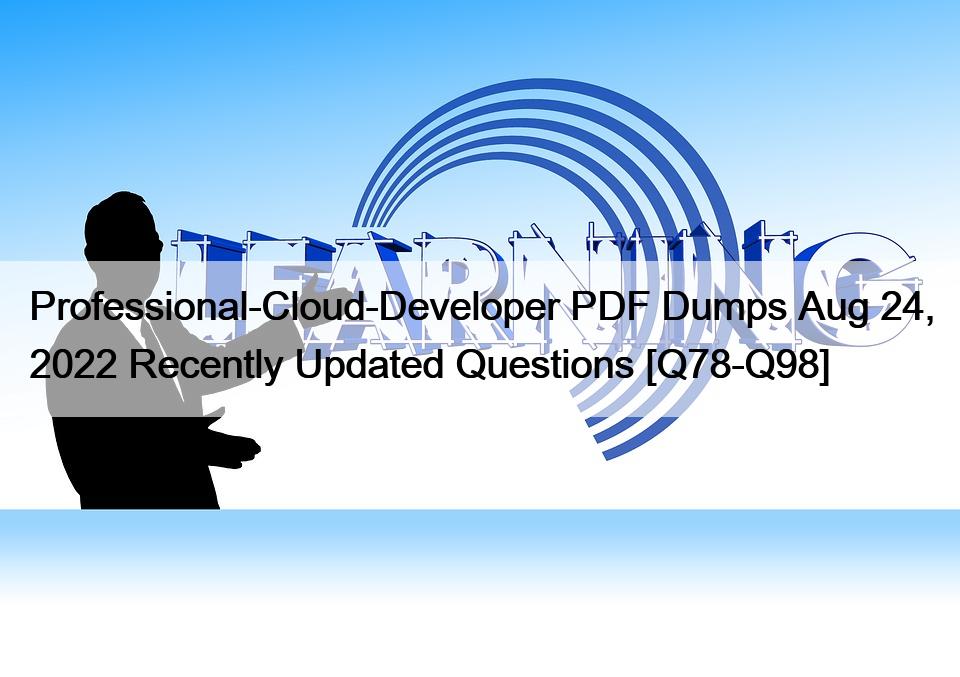
Professional-Cloud-Developer PDF Dumps | Aug 24, 2022 Recently Updated Questions
Professional-Cloud-Developer Exam Questions – Valid Professional-Cloud-Developer Dumps Pdf
How much Google Professional Cloud Developer Exam cost
Google Professional Cloud Developer exam cost is $120 USD(40% discount on retail price of $200 USD).
Topics of Google Professional Cloud Developer Exam
Candidates must know the exam topics before they start of preparation.
because it will really help them in hitting the core.
Our Google Professional Cloud Developer Dumps will include the following topics:
1. Designing highly scalable, available, and reliable cloud-native applications
Designing high-performing applications and APIs
- Evaluating different services and technologies
- Caching solutions
- Geographic distribution of Google Cloud services (e.g., latency, regional services, zonal services)
- Google-recommended practices and documentation
- Deploying and securing API services
- Scaling velocity characteristics/tradeoffs of IaaS (infrastructure as a service) vs. CaaS (container as a service) vs. PaaS (platform as a service)
- Loosely coupled applications using asynchronous Cloud Pub/Sub events
- Defining a key structure for high-write applications using Cloud Storage, Cloud Bigtable, Cloud Spanner, or Cloud SQL
- Microservices
- Graceful shutdown on platform termination
Designing secure applications
- Implementing requirements that are relevant for applicable regulations (e.g., data wipeout)
- Securing service-to-service communications (e.g., service mesh, Kubernetes network policies, and Kubernetes namespaces)
- Authenticating to Google services (e.g., application default credentials, JWT, OAuth 2.0)
- Security mechanisms that secure/scan application binaries and manifests
- Google-recommended practices and documentation
- Certificate-based authentication (e.g., SSL, mTLS)
- IAM roles for users/groups/service accounts
Managing application data
- Choosing data storage options based on use case considerations, such as:
- Strong vs. eventual consistency
- Structured vs. unstructured data
- Following Google-recommended practices and documentation
- Defining database schemas for Google-managed databases (e.g., Cloud Firestore, Cloud Spanner, Cloud Bigtable, Cloud SQL)
- Data volume
Refactoring applications to migrate to Google Cloud
- Migrating a monolith to microservices
- Google-recommended practices and documentation
- Using managed services
2 Building and Testing Applications
Setting up your local development environment
- Emulating Google Cloud services for local application development
- Creating Google Cloud projects
Writing code
- Efficiency
- Modern application patterns
- Agile software development
- Algorithm design
- Unit testing
Testing
- Performance testing
- Load testing
- Integration testing
Building
- Developing a continuous integration pipeline using services (e.g., Cloud Build, Container Registry) that construct deployment artifacts
- Creating container images from code
- Reviewing and improving continuous integration pipeline efficacy
- Creating a Cloud Source Repository and committing code to it
3 Deploying applications
Recommend appropriate deployment strategies for the target compute environment (Compute Engine, Google Kubernetes Engine). Strategies include:
- Blue/green deployments
- Traffic-splitting deployments
- Canary deployments
- Rolling deployments
Deploying applications and services on Compute Engine
- Managing Compute Engine VM images and binaries
- Installing an application into a VM
- Modifying the VM service account
- Manually updating dependencies on a VM
- Exporting application logs and metrics
Deploying applications and services to Google Kubernetes Engine (GKE)
- Define deployments, services, and pod configurations
- Managing container lifecycle
- Managing Kubernetes RBAC and Google Cloud IAM relationship
- Deploying a containerized application to GKE
- Building a container image using Cloud Build
- Configuring application accessibility to user traffic and other services
Deploying a Cloud Function
- Cloud Functions that are invoked via HTTP
- Securing Cloud Functions
- Cloud Functions that are triggered via an event (e.g., Cloud Pub/Sub events, Cloud Storage object change notification events)
Using service accounts
- Creating a service account according to the principle of least privilege
- Downloading and using a service account private key file
4 Integrating Google Cloud Platform Services
Integrating an application with data and storage services
- Connecting to a data store (e.g., Cloud SQL, Cloud Spanner, Cloud Firestore, Cloud Bigtable)
- Read/write data to/from various databases (e.g., SQL, JDBC)
- Using the command-line interface (CLI), Google Cloud Console, and Cloud Shell tools
- Writing an application that publishes/consumes data asynchronously (e.g., from Cloud Pub/Sub)
- Storing and retrieving objects from Cloud Storage
Integrating an application with compute services
- Authenticating users by using OAuth2.0 Web Flow and Identity Aware Proxy
- Implementing service discovery in Google Kubernetes Engine and Compute Engine
- Using the command-line interface (CLI), Google Cloud Console, and Cloud Shell tools
- Reading instance metadata to obtain application configuration
Integrating Google Cloud APIs with applications
- Error handling (e.g., exponential backoff)
- Using service accounts to make Google API calls
- Restricting return data
- Caching results
- Enabling a Google Cloud API
- Paginating results
- Making API calls with a Cloud Client Library, the REST API, or the APIs Explorer, taking into consideration:
5 Managing Application Performance Monitoring
Managing Compute Engine VMs
- Analyzing logs
- Debugging a custom VM image using the serial port
- Sending logs from a VM to Cloud Monitoring
Managing Google Kubernetes Engine workloads
- Analyzing container lifecycle events (e.g., CrashLoopBackOff, ImagePullErr)
- Configuring workload autoscaling
- Analyzing logs
- Using external metrics and corresponding alerts
- Configuring logging and monitoring
Troubleshooting application performance
- Viewing logs in the Google Cloud Console
- Using documentation, forums, and Google support
- Profiling services
- Graphing metrics
- Profiling performance of request-response
- Using Cloud Debugger
- Writing custom metrics and creating metrics from logs
- Monitoring and profiling a running application
- Reviewing application performance (e.g., Cloud Trace, Prometheus, OpenCensus)
How to book Google Professional Cloud Developer Exams
The registration for the Google Professional Cloud Developer Exam follows the steps given below.
- Step 1: Visit the Google Cloud Webassessor Website
- Step 2: Sign in or sign up to your Google Cloud Webassessor account
- Step 3: Search for the exam name Google Professional Cloud Developer
- Step 4: Take the date of the exam, choose exam center and make further payment using payment method like credit/debit etc.
Professional-Cloud-Developer dumps Sure Practice with 140 Questions: https://www.dumpstorrent.com/Professional-Cloud-Developer-exam-dumps-torrent.html